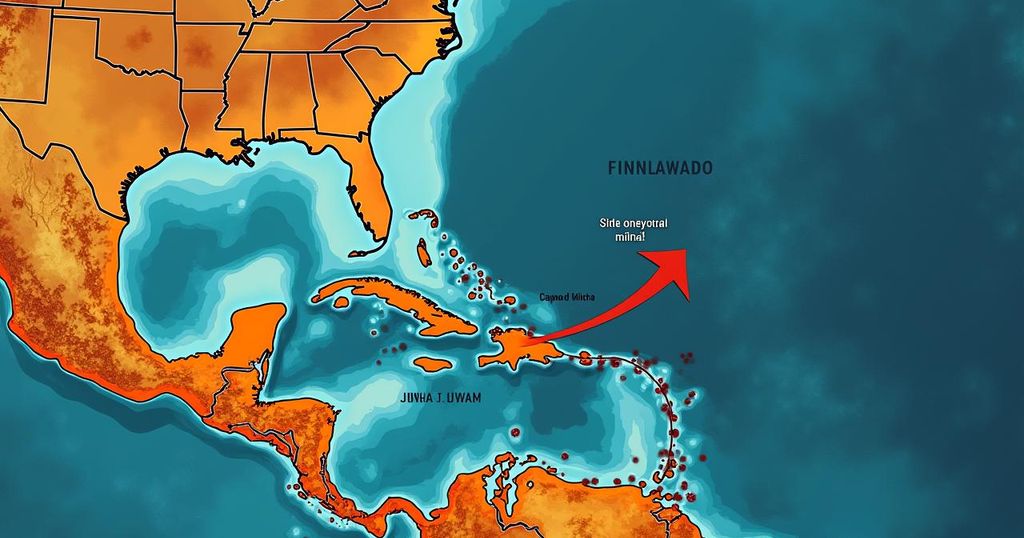Hurricane Milton Tracker: Impacts and Preparedness Measures

Hurricane Milton has been downgraded to Category 4 and is expected to make landfall in western Florida, bringing anticipated heavy rainfall, storm surge, and damaging winds. The storm follows the recent devastation wrought by Hurricane Helene, which resulted in over 220 fatalities. With forecasts predicting a potentially severe hurricane season, officials stress the importance of preparedness for storm-related impacts.
Hurricane Milton, currently classified as a Category 4 hurricane, has formed in the Gulf of Mexico, having been downgraded from Category 5 during the previous night. Current forecasts predict that Milton is expected to make landfall on the western coastline of Florida, where it will likely bring significant rainfall, storm surge, and dangerous winds. The National Hurricane Center anticipates that the impact from Hurricane Milton could stretch well beyond the immediate landfall area, causing potential flooding in Florida due to ongoing heavy rainfall leading to Milton’s arrival, which is projected for Wednesday. If the current trajectory of Hurricane Milton persists, it would mark the second hurricane to impact Florida within a fortnight following the arrival of Hurricane Helene, which struck as a Category 4 hurricane and resulted in unprecedented storm surges across the Gulf coast. It is important to note that Helene has been attributed to over 220 fatalities along its path spanning from Florida to Virginia. The formation and intensification of hurricanes hinge on specific meteorological conditions being present for an extended period, combined with adequate warm ocean waters. The National Hurricane Center diligently monitors tropical cyclones’ wind speeds to assign their classifications; once the wind speed reaches 39 mph for at least one minute, the storm is designated as a tropical storm, and at 74 mph, it escalates to a Category 1 hurricane, advancing up to Category 5. These classifications are crucial for emergency officials as they assess potential risks and damages, providing timely warnings regarding hazardous winds, heavy rains, and flooding that may result from the hurricane’s landfall. The dangers associated with tropical storm-force winds cannot be overstated, as stronger hurricane-force winds possess the capacity to demolish structures and project debris over considerable distances. Furthermore, as the storm progresses inland, flooding becomes a critical threat. Hurricanes can generate excessive rain, often exceeding six inches, thereby overwhelming drainage systems and saturating the ground, resulting in flash floods that can linger for several days post-storm. Historically, the peak of the hurricane season occurs in mid-September, with the National Oceanic and Atmospheric Administration forecasting a potentially unprecedented season this year. Authorities estimate that the current hurricane season may witness 17 to 25 tropical storms, including a range of four to seven that could develop into major hurricanes.
The current status of Hurricane Milton, amid the backdrop of a heightened hurricane season, exemplifies the escalating nature of extreme weather systems in the Atlantic Ocean. The National Hurricane Center plays a pivotal role in tracking these storms, analyzing wind speeds for classification, and issuing safety warnings to mitigate risks associated with severe weather events. The recent impact of Hurricane Helene serves as a grim reminder of the lethal capacities hurricanes can possess, having resulted in significant loss of life and property damage across multiple states. As coastal and inland communities brace for Hurricane Milton, the precedence of safeguarding lives, infrastructure, and property stands paramount.
In summary, Hurricane Milton presents a formidable threat to the western Florida peninsula, with forecasts indicating severe weather conditions characterized by heavy rainfall, strong winds, and flooding. The lessons learned from recent hurricane activity, including the tragic impact of Hurricane Helene, underscore the importance of preparedness and the need for effective response strategies to minimize loss and protect communities. As meteorological predictions suggest an above-average hurricane season, vigilance remains paramount.
Original Source: www.washingtonpost.com








